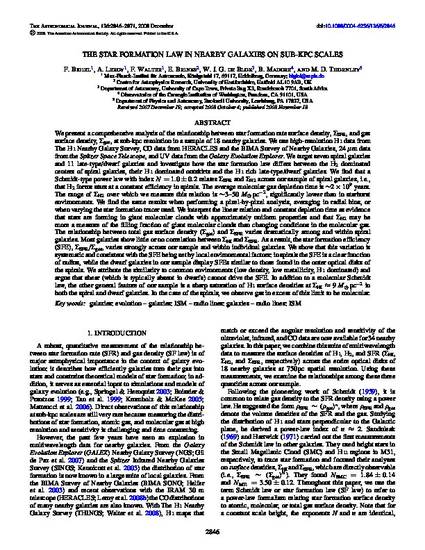
Article
THE STAR FORMATION LAW IN NEARBY GALAXIES ON SUB-KPC SCALES
Astronomical Journal
(2008)
Abstract
We present a comprehensive analysis of the relationship between star formation rate surface density, ΣSFR, and gas surface density, Σgas, at sub-kpc resolution in a sample of 18 nearby galaxies. We use high-resolution H I data from The H I Nearby Galaxy Survey, CO data from HERACLES and the BIMA Survey of Nearby Galaxies, 24 μm data from the Spitzer Space Telescope, and UV data from the Galaxy Evolution Explorer. We target seven spiral galaxies and 11 late-type/dwarf galaxies and investigate how the star formation law differs between the H2 dominated centers of spiral galaxies, their H I dominated outskirts and the H I rich late-type/dwarf galaxies. We find that a Schmidt-type power law with index N = 1.0 ± 0.2 relates ΣSFR and ΣH2 across our sample of spiral galaxies, i.e., that H2 forms stars at a constant efficiency in spirals. The average molecular gas depletion time is ~2 × 109 years. The range of ΣH2 over which we measure this relation is ~3-50 M sun pc-2, significantly lower than in starburst environments. We find the same results when performing a pixel-by-pixel analysis, averaging in radial bins, or when varying the star formation tracer used. We interpret the linear relation and constant depletion time as evidence that stars are forming in giant molecular clouds with approximately uniform properties and that ΣH2 may be more a measure of the filling fraction of giant molecular clouds than changing conditions in the molecular gas. The relationship between total gas surface density (Σgas) and ΣSFR varies dramatically among and within spiral galaxies. Most galaxies show little or no correlation between ΣHI and ΣSFR. As a result, the star formation efficiency (SFE), ΣSFR/Σgas, varies strongly across our sample and within individual galaxies. We show that this variation is systematic and consistent with the SFE being set by local environmental factors: in spirals the SFE is a clear function of radius, while the dwarf galaxies in our sample display SFEs similar to those found in the outer optical disks of the spirals. We attribute the similarity to common environments (low density, low metallicity, H I dominated) and argue that shear (which is typically absent in dwarfs) cannot drive the SFE. In addition to a molecular Schmidt law, the other general feature of our sample is a sharp saturation of H I surface densities at ΣHI ≈ 9 M sun pc-2 in both the spiral and dwarf galaxies. In the case of the spirals, we observe gas in excess of this limit to be molecular.
Disciplines
Publication Date
Winter December 1, 2008
Citation Information
F. Bigiel, A. Leroy, F. Walter, E. Brinks, et al.. "THE STAR FORMATION LAW IN NEARBY GALAXIES ON SUB-KPC SCALES" Astronomical Journal (2008) Available at: http://works.bepress.com/michele-thornley/1/